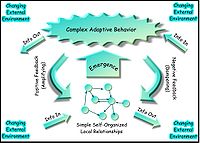
Photo from wikipedia
In the animal world, various kinds of collective motions have been found and proven to be efficient ways of carrying out some activities such as searching for food and avoiding… Click to show full abstract
In the animal world, various kinds of collective motions have been found and proven to be efficient ways of carrying out some activities such as searching for food and avoiding predators. Many scholars research the interactions of collective behaviors of human beings according to the rules of collective behaviors of animals. Based on the Lennard-Jones potential function and a self-organization process, our paper proposes a topological communication model to simulate the collective behaviors of human beings. In the results of simulations, we find various types of collective behavior and fission behavior and discover the threshold for the emergence of collective behavior, which is the range five to seven for the number of topology K. According to the analysis of network properties of the model, the in-degree of individuals is always equal to the number of topology. In the stable state, the out-degrees of individuals distribute around the value of the number of topology K, except that the out-degree of a single individual is approximately double the out-degrees of the other individuals. In addition, under different initial conditions, some features of different kinds of networks emerge from the model. We also find the leader and herd mentality effects in the characteristics of the behaviors of human beings in our model. Thus, this work could be used to discover how to promote the emergence of beneficial group behaviors and prevent the emergence of harmful behaviors.
Journal Title: PLoS ONE
Year Published: 2017
Link to full text (if available)
Share on Social Media: Sign Up to like & get
recommendations!